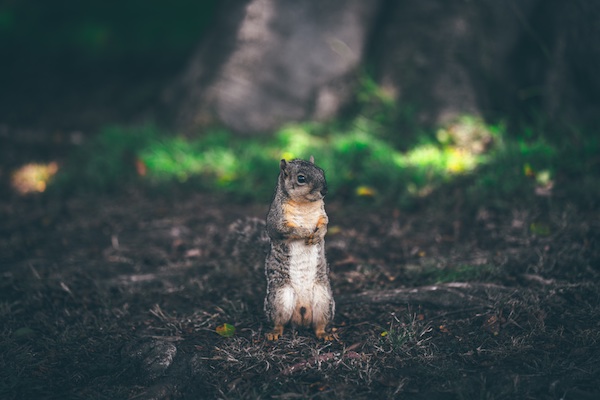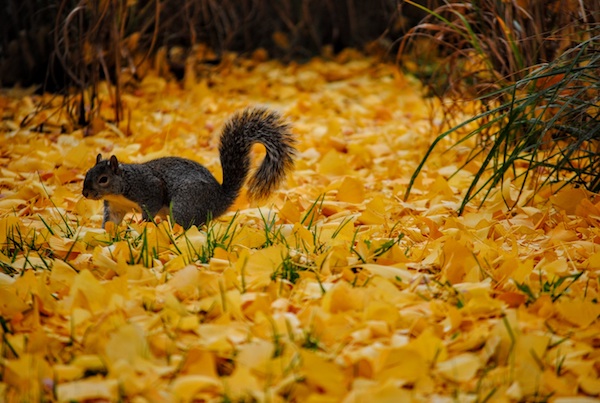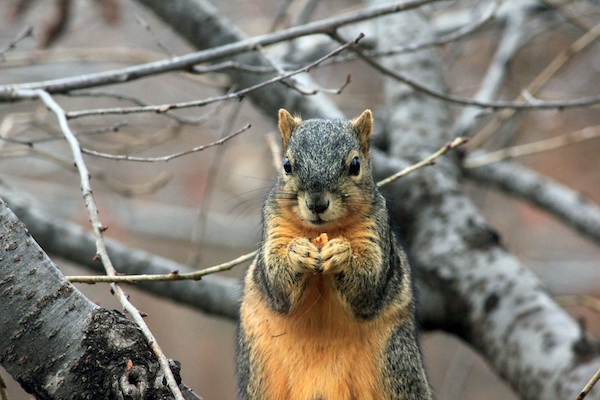A Way of Life in the USA
Hunting is a way of life in the United States, and we are here to help you be as successful on the hunt as possible.
Category Archives for Small Game Hunting

Squirrel Hunting Tips for Newbies and Experts
 Sounds easy enough to just go into the woods and shoot a squirrel, or if you’re like me and have squirrels in your backyard, just go out there and shoot a few of them.
Sounds easy enough to just go into the woods and shoot a squirrel, or if you’re like me and have squirrels in your backyard, just go out there and shoot a few of them.
But there are things to consider. What time of year/day are they most abundant? What type of gun do you need? If they are out and about, where would you find them if not in your backyard? Is the hunt over if you startle your prey away?
Here are a few helpful tips when it comes to hunting these bushy-tailed critters.
To Sit and Wait or to Stalk
There are two ways to hunt squirrels. You can either:
- Sit and wait for the squirrels to come out
- Stalk your prey
There’s a good chance that you’ll be able to catch a squirrel unaware by picking a location you’re certain they’ll show up and just waiting. It sounds simple, but there are some issues with this method.
If it’s early in the squirrel hunting season, the nuts that they love to eat may not have fallen yet. This means that instead of squirrels being on the ground foraging for nuts, they’ll be in the trees cutting nuts loose, and they may be too high to reach with a shotgun. Waiting for squirrels to come down to retrieve their food takes a lot of time and patience.
Another issue with waiting for your prey to appear is that you must be in the right place at precisely the right time to catch a squirrel, or it doesn’t work.
If you feel like sitting and waiting for a squirrel to appear isn’t your thing, you can always go and stalk your prey. When the trees are in full bloom, it can be difficult to spot squirrels. But if you’re stalking them, you can spot moving leaves that indicate a squirrel is nearby.
Stalking is a hallmark of woodsmanship. It involves moving quietly through the woods, going undetected by your prey. Squirrel hunting is similar to deer hunting, with the only differences being the size of the target and the possible location of it.
Stalking is good for the young hunter. Instead of sitting for hours waiting to land the perfect shot, they learn how to sneak through the woods. It also gives them the chance to make more than one shot, helping them make more accurate shots later on.
The only disadvantage associated with stalking is that it may be difficult to see a bushy tail before it sees you. If one of the bushy-tailed critter are in the trees the foliage may move to let you know a squirrel’s there, but the squirrel may be able to see you just as well.
 Listen For Your Prey
Listen For Your Prey
If you can hear cutting, or the sound of debris falling as squirrels feed on nuts in the trees, you’ve hit the jackpot!
The hunter should enter the woods quietly, listening for the sounds of squirrels jumping from tree to tree, gnawing on nutshells, and and wheezing to announce to all of the furry kind their territory.
Squirrels love all kinds of nuts, but if you’re hunting in September, squirrels will prefer beechnuts to all others. During the preseason, be sure to scout out areas that have beechnut trees.
Speaking of food, squirrels also love corn, and finding squirrels in corn fields gives you the advantage to see squirrels more easily because they’re on the ground. You may also have the opportunity to land multiple shots since their dens will usually be located in corn fields as well.
Shoot Precisely and Safely
When you’ve got your target, move slowly into position. The target’s small, so if you would like to increase your chances of hitting your target, it’s best to get some practice in before the season starts.
A point to keep in mind at all times: make sure you have a backstop. If you’re stalking or waiting for prey to climb through the trees, you’ll be shooting up, so if you miss you need to make sure that the bullet hits a tree. The same goes for when you’re hunting squirrels on the ground. Be sure you have a backstop if you miss the squirrel.
A head shot is preferred, but it’s understandable if you can’t make the shot, so shoulder shots will do.
Know Your Prey
Woodland squirrels and backyard squirrels are completely different.
Backyard squirrels are used to human activity, and have adjusted to our activities so much that they are almost “tame”. Woodland squirrels, on the other hand, are used to no humans nor their activities. One predator is just as bad as another to them, so their natural reaction is avoidance.
With that being said, sitting in your backyard and waiting for a squirrel to appear may work just fine, but it may not work so well in the woods. The latter may require you to quietly stalk your prey.
Know How Bushy-tailed Critters Operate
Squirrels are particularly active during dawn and dusk. During the early part of the season, squirrels will leave their dens at dawn to harvest nuts. They feed throughout the day, so there’s no need to rush.
What to Do If You’re Detected
If you’re stalking or sitting quietly in the woods, and you suddenly notice that the woods have gone silent and still, it either means that the squirrels know you’re there or that something else is there with you.
If you find yourself in this situation, look for a ridge that sits high above the ground, do not move nor make any noise, and wait for the squirrels to reappear. 20 minutes or more may pass before they reappear, but they’ll most likely come back.
Wait as long as you possibly can, and then another 15 minutes. If you don’t see them, then play it safe and move on.
Give Yourself Multiple Opportunities to Score
During the early portion of the hunting season you’ll find multiple squirrels in one tree, especially in hickory and oak trees, meaning plenty of opportunities to bring home fresh squirrels.
When you fire a shot, reload quickly, and instead of running out to get the downed squirrel, wait a few minutes. Many times, several squirrels will come back out and continue to feed (as if nothing has happened), giving you more opportunities for more shots.
Use the Seasons to Determine if Squirrels Will Appear Above or Below You
When the season starts, you’ll see squirrels in trees looking for nuts to munch on. As the season progresses, a good portion of the nuts will have fallen to the ground. During the middle portion of the squirrel hunting season, squirrels are now forage on the ground for fallen nuts. They’ll come out of their dens and onto ground by using fallen limbs and exposed tree trunks.
Be sure to let the squirrel get reach ground. A squirrel that’s just leaving its den will make for a poor target because they’re moving erratically. Let them reach the nut, even let them begin to enjoy their last meal. They’re focused on their meal, not their surroundings.
During the later portion of the season, squirrels are lazy due to a lack of food. With this in mind, they’ll still come out at dawn and dusk, but for shorter periods of time. In fact, hunting squirrels near the end of the season may be one of the best things you can do since food is scarce. Squirrels do not congregate when food is plentiful, they congregate and compete for it when it’s scarce.
Another way to gather more than one squirrel at a spot is to find a den tree. Den trees are large, twisted specimens that are full of holes, which offers plenty of hiding places. Keep your eyes peeled for dens that could be located in creeks as well.
 Your Gun Type Will Depend on How Good You Are
Your Gun Type Will Depend on How Good You Are
If you want to kill as many squirrels as possible in a short amount of time, then you’ll need a shotgun. A shotgun can shoot moving targets and it’s better at shooting through obstructions like leaves in the trees that are hiding squirrels. It’s also perfect for beginners.
There are a few drawbacks. One is that the range of a shotgun is only 40 yards. You can’t be too far from your target, but you don’t need to be too close either. A bushy-tailed critter’s meat shot at close range with a shotgun is ruined. The report is also much louder on this gun than a .22, which will scare away squirrels and any other game in the area, which makes the loss hurt all the more.
If you’re a more experienced hunter with good accuracy, a .22 may be what you want to use. The shells are cheaper than shotgun shells, and it can kill squirrels at longer ranges. It’s also quieter, causing less of a disturbance. You’ll also be able to use all of the meat.
Since bullets from a .22 can travel up to one and a half miles, shots should be taken either on the ground or in front of a solid back stop.
A Squirrel Call Could Be Helpful
Some squirrels can be brought out of hiding with a squirrel call. The issue with this is that squirrel calls are harder to make than turkey calls. Also, squirrels are probably smarter than turkeys, so they may not fall for the call so easily.
To make the call work as best you can, stay out of feeding and den areas. Travel corridors between woodlands and cornfields are perfect for these calls. This makes for a good situation for a squirrel call.
Usually squirrels use drainage ditches to travel between feeding grounds and their dens. Their home could be hundreds of yards away from feeding areas, opposed to most crop areas where the dens are usually in the same area.
Other squirrels probably won’t be alarmed at the sound of a gun shot if they’re not even in range to hear it, so more opportunities for you.
Taking to the Water May Be a Viable Option
Float hunting is really effective. Float hunting is hunting that is done in a canoe or kayak. Canoe and kayak hunters don’t move as much as when they’re walking, and float hunting in general doesn’t make much noise at all.
One of the big advantages of float hunting is that creek bottoms can contain some of the best squirrel habitats you’ll find. In fact, stream bottoms in secluded farming country may be the only place where you’ll be able to find a squirrel den in a broad area.
Some creek bottoms are so wet and dense with cover that squirrels are lightly hunted, meaning that squirrels will likely let their guard down in these places. If anything, they’re more curious than fearful of hunters in boats in creeks.
They’ll even scamper onto an overhanging limb on the creek and reprimand hunters with a series of screeches, making for easy shots. But be careful though: Don’t shoot squirrels that could fall into the water, because they will sink!
You’ll want to use a shotgun for float hunting. Shooting opportunities will be brief, and most of your shots will be aimed at moving targets. There’s no need to be choosy when deciding what shots to take. As long as you’re sure you won’t be hitting any buildings, roads, or people, you’re fine.
Hopefully these tips make squirrel hunting less of a pain in the neck (pun intended). Be sure to know what time/season you prefer to hunt in, squirrel den locations, what type of gun you would like to use, and whatever else you may need.
Keep all other tips above in mind, shoot well, and take care.
